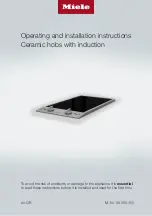
11
n
We recommend that the hob be connected
by means of a fixed pipe. Connection using
a specially designed safety hose is also
permitted. In all cases the connection tap
for the appliance must be positioned such
that it is easily accessible, in an adjacent
kitchen cupboard, for example.
Please note:
A safety hose may not be bent and must not
come into contact with the hot parts of the
built-in oven or moving parts of kitchen units,
such as a drawer.
n
Before using the appliance for the first
time check the connections using water
and washing-up liquid to ensure that there
are no gas leaks.
n
After installation check that the appliance
and the burners are working properly; the
gas flames should be regular and stable
when full on and the burners should not go
out when turned to the lowest setting.
Please note:
Do not install a hob next to a high cupboard or
wall made of flammable material. (If there is
no alternative, ensure that there is a minimal
distance of 40 mm between the outer edge of
the hob and the wall in question. Also ensure
that there is a minimum distance of 65 cm
between the hob and any overhead extractor
fan which may be installed.)
Positioning
1.
Make a hole in the side of the kitchen cabinet
to enable the gas pipe to be passed through.
2.
Stick the strips of sealant to the underside of
the hob (see above).
3.
Place the appliance in the cut-out.
4.
Secure the appliance in position.
5.
Make the gas connection. Check the gas
connections with a soap/water mixture
(see “Gas Connection”).
6.
Put the plug in the socket
(see “Electrical Connection”).
7.
Test to check the appliance is operational.
The building in of the hob in combination with a
built-in oven is described in the installation guide
for the oven.
Attention!
n
The underside of this built-in hob becomes
hot. Take care that you do not place any
flammable or plastic objects in any drawer
under the appliance.!
fig. 5
fig. 6
installation/positionin
G
montageklem A
montageklem B
700003288000_GK299.indd 11
30-11-2009 14:26:44













































